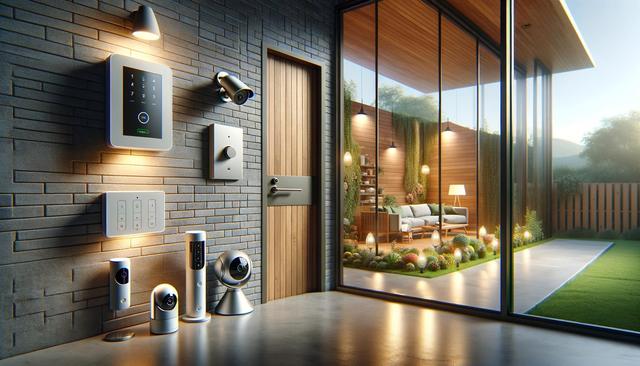
Enhancing Peace of Mind: A Practical Look at Home Security Systems
Understanding the Basics of Home Security Systems
Home security systems are designed to safeguard residential properties from various threats such as burglary, fire, and unauthorized access. At their core, these systems typically consist of a network of devices including sensors, alarms, cameras, and control panels. Some systems are monitored by a professional service, while others can be self-monitored through mobile apps, offering flexibility depending on users’ needs and preferences.
There are generally two types of home security systems: wired and wireless. Wired systems are typically more difficult to install but offer a stable connection, while wireless systems are easier to set up and can be relocated if the homeowner moves. Many modern systems also integrate with smart home features, allowing residents to control lights, locks, and even thermostats remotely. This integration adds a layer of convenience and can also improve energy efficiency.
In choosing a system, homeowners should consider factors such as property size, neighborhood safety, and their personal comfort with technology. It’s also important to evaluate whether professional installation is required or if a do-it-yourself setup is feasible. A well-informed decision can significantly enhance the effectiveness of the security measures put in place.
Key Components and How They Work Together
Each part of a home security system plays a specific role in ensuring comprehensive protection. The synergy between these components is what allows the system to function effectively. Here are some of the most common elements:
- Control Panel: The central hub that communicates with all devices in the system.
- Door and Window Sensors: Trigger alerts when openings are breached.
- Motion Detectors: Detect movement in areas where there shouldn’t be any.
- Security Cameras: Provide visual monitoring and can record footage for later review.
- Alarm Sirens: Sound off to alert homeowners and deter intruders.
These components are connected either via physical wiring or wireless signals, and they often work in conjunction with a centralized app or platform. Many systems also offer features such as panic buttons and environmental sensors for detecting smoke, carbon monoxide, or flooding.
By understanding how these components interact, homeowners can better assess what equipment is necessary for their particular situation. Not every home requires every feature, but having the right combination can make a significant difference in overall security.
Benefits Beyond Theft Prevention
While preventing break-ins is a primary benefit of home security systems, there are several additional advantages that make them a valuable investment. One of the most important is the potential for early detection of hazards. Systems equipped with smoke and carbon monoxide detectors can alert residents to danger before it becomes life-threatening.
Another benefit is the increased sense of control and peace of mind. With modern systems offering remote access, users can check in on their property from anywhere using a smartphone or computer. This is especially useful for frequent travelers or individuals who work long hours away from home.
Additional advantages include:
- Lower homeowners insurance premiums: Many insurance companies offer discounts for homes equipped with security systems.
- Improved emergency response: Monitored systems can automatically contact emergency services when an alarm is triggered.
- Support for elderly or vulnerable residents: Some systems include features like medical alert buttons or fall detection.
These benefits collectively enhance not only the safety but also the quality of life for households using home security systems.
Considerations When Choosing a System
With numerous home security options available, selecting the right one can feel overwhelming. However, by focusing on a few key considerations, the decision-making process becomes more manageable. Start by identifying the specific needs of your household. For example, a large home with multiple entry points may require more sensors and cameras than a small apartment.
Budget is another important factor. While some systems involve a significant upfront cost, others operate on a subscription model with monthly fees. It’s also essential to determine whether you prefer professional monitoring or are comfortable managing the system yourself via an app.
Here are some questions to guide your selection process:
- Do you want a system that integrates with your existing smart home devices?
- Is professional installation necessary, or would a DIY kit suffice?
- Are mobile notifications and remote access important to you?
- What kind of customer support does the provider offer?
Researching user reviews and checking for certifications or third-party testing can also help ensure you’re choosing a reliable and effective system. Ultimately, the goal is to find a solution that fits seamlessly into your lifestyle while providing the level of protection you need.
Maintaining and Maximizing Your Security System
Once a home security system is installed, maintaining it is essential to ensure ongoing effectiveness. Regular maintenance not only prolongs the life of the system but also ensures that it functions correctly in an emergency. This includes checking batteries, updating firmware, and testing alarms periodically.
Most modern systems allow for easy troubleshooting through their companion apps or web portals. Alerts can inform users if a sensor is offline or if there is a connectivity issue. Scheduling routine checks—either manually or through a service provider—can prevent small issues from becoming major security vulnerabilities.
Maximizing the value of your security system involves more than just maintenance. It’s also about using its features to their fullest potential. For example:
- Set up customized alerts for specific events, such as doors opening during certain hours.
- Utilize video storage options to review past events if needed.
- Train all household members on how to arm and disarm the system properly.
Staying informed about available software updates and new features can also help you keep your system current. Some providers offer additional services or upgraded components that can be added over time, allowing your security setup to evolve with your needs.


